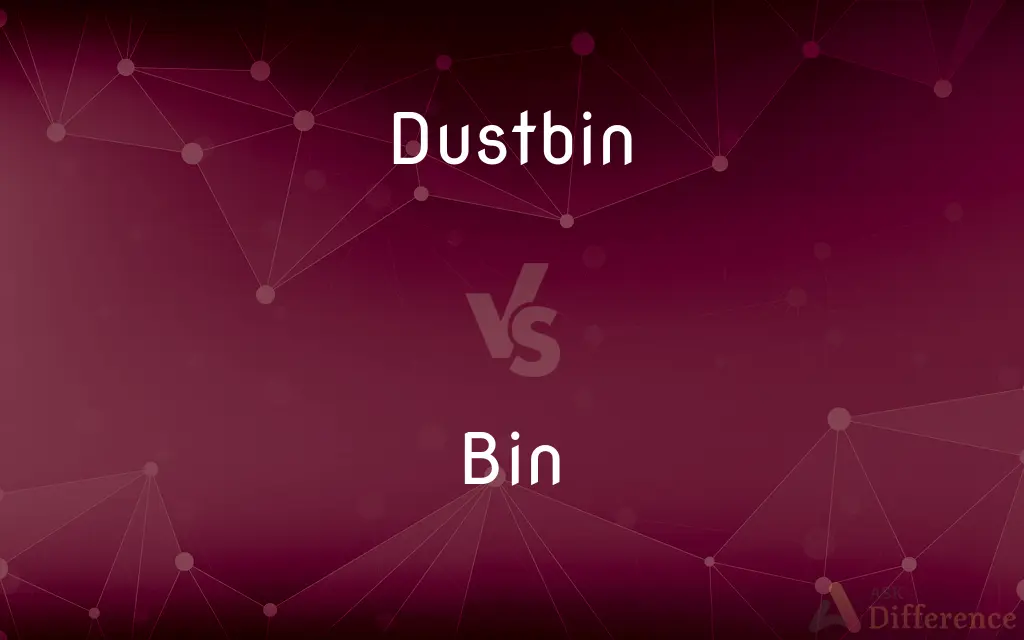Dustbin vs. Bin — What's the Difference?
By Urooj Arif & Fiza Rafique — Updated on March 20, 2024
A dustbin is specifically designed for holding waste until disposal, commonly used in households and public spaces; a bin can refer to any container used for storage or waste.

Difference Between Dustbin and Bin
Table of Contents
ADVERTISEMENT
Key Differences
Dustbins are containers specifically designated for collecting and holding waste materials, often found in both residential and public settings. They are typically equipped with lids to contain odors and are made from materials like plastic or metal that are easy to clean. In contrast, the term "bin" has a broader application and can refer to any type of container used for storing items, including waste, but also for organizing goods, such as in a pantry or for tools in a workshop. While all dustbins are bins designed for waste, not all bins are used for waste disposal; some serve for storage or organization.
The design of a dustbin often includes features to facilitate waste management, such as pedal-operated lids, wheels for mobility, and compartments for separating recyclables from general waste. Bins, on the other hand, may come in various shapes and sizes, with or without lids, and are used in a wide range of contexts beyond waste collection, including in homes, offices, and industrial settings for storing a variety of items.
Dustbins are crucial in maintaining hygiene and cleanliness in an area by securely containing waste until it can be properly disposed of or recycled. They play a key role in waste management systems, helping to prevent littering and reduce the spread of pests and diseases. Bins used for purposes other than waste disposal help in organizing space, keeping items contained, and can be specialized, like grain bins in agricultural settings or parts bins in manufacturing.
While dustbins are primarily functional and focused on practicality and hygiene, bins designed for storage or other uses can vary widely in aesthetics and material, often chosen to match interior design or specific storage needs. For example, decorative bins might be used in living spaces for organizing magazines or toys, reflecting their versatility beyond waste containment.
The distinction between dustbins and bins lies in their intended use, with dustbins serving a specific role in waste management, whereas bins can be utilized for a broad array of storage and organizational purposes. Both, however, are essential in their contexts, contributing to cleanliness, efficiency, and organization.
ADVERTISEMENT
Comparison Chart
Primary Use
Collecting and holding waste until disposal.
Storing various items, including waste.
Design
Often has lids, may include pedals or wheels.
Can vary greatly, with or without lids.
Material
Usually plastic or metal for easy cleaning.
Can be made from a wide range of materials.
Location
Found in households, public spaces, and businesses for waste.
Used in homes, offices, industries for storage and waste.
Purpose
Maintains hygiene, reduces pests, manages waste.
Organizes space, contains items, may also hold waste.
Compare with Definitions
Dustbin
A container for temporarily storing waste.
She threw the apple core into the dustbin.
Bin
Can be specialized, like parts or grain bins.
The farmer stored the harvested wheat in large grain bins.
Dustbin
Often found in kitchens, bathrooms, and public areas.
The park has several dustbins for picnic waste.
Bin
Versatile in use, not limited to waste.
The pantry bins were filled with grains and spices.
Dustbin
Plays a role in waste management systems.
The household separates recyclables into a different section of the dustbin.
Bin
A container used for storage or holding items.
She organized the tools in a bin in the garage.
Dustbin
Designed to keep areas clean and odor-free.
The sealed lid on the dustbin helps contain smells.
Bin
Material and design vary based on purpose.
Decorative bins in the living room hold magazines and blankets.
Dustbin
May have features like pedals for hands-free opening.
He used the pedal to open the dustbin and dispose of the trash.
Bin
Aids in organizing and decluttering spaces.
He bought several bins to organize his workshop.
Dustbin
A can or barrel for refuse.
Bin
A container or enclosed space for storage.
Dustbin
A bin for holding rubbish until it can be collected; a garbage can.
Bin
To place or store in a bin.
Dustbin
A bin that holds rubbish until it is collected.
Bin
A box, frame, crib, or enclosed place, used as a storage container.
A corn bin
A wine bin
A coal bin
Dustbin
A bin that holds rubbish until it is collected
Bin
A container for rubbish or waste.
A rubbish bin
A wastepaper bin
An ashes bin
Bin
(statistics) Any of the discrete intervals in a histogram, etc
Bin
Any of the fixed-size chunks into which airspace is divided for the purposes of radar.
Bin
Jail or prison.
Bin
(in Arabic names) son of; equivalent to Hebrew tr=ben.
Bin
(computing) binary
Bin
To dispose of (something) by putting it into a bin, or as if putting it into a bin.
Bin
To throw away, reject, give up.
Bin
(statistics) To convert continuous data into discrete groups.
Bin
(transitive) To place into a bin for storage.
To bin wine
Bin
Alternative form of been
Bin
A box, frame, crib, or inclosed place, used as a receptacle for any commodity; as, a corn bin; a wine bin; a coal bin.
Bin
To put into a bin; as, to bin wine.
Bin
An old form of Be and Been.
Bin
A container; usually has a lid
Bin
The quantity contained in a bin
Bin
An identification number consisting of a two-part code assigned to banks and savings associations; the first part shows the location and the second identifies the bank itself
Bin
Store in bins
Common Curiosities
Why do some dustbins have pedals?
Pedals allow for hands-free opening, reducing the spread of germs and making waste disposal more hygienic.
How does a dustbin contribute to cleanliness?
By securely containing waste and odors, dustbins help maintain hygiene and reduce the spread of pests in an area.
Can a bin be used as a dustbin?
Yes, a bin can be repurposed as a dustbin if it's suitable for holding waste.
What materials are dustbins typically made from?
Dustbins are commonly made from plastic or metal, chosen for durability and ease of cleaning.
Can recycling be considered when using dustbins and bins?
Yes, both dustbins and bins can be part of a recycling system, with separate containers for different materials to facilitate recycling processes.
What is the difference between a dustbin and a garbage can?
There is no fundamental difference; "dustbin" and "garbage can" are terms that can be used interchangeably, though usage may vary by region.
Are bins only used for storage?
While bins are often used for storage, they can also be used for waste, depending on the context and design.
Can bins be decorative?
Yes, bins can be decorative and are often chosen to complement interior designs, especially when used for storage in living spaces.
Why are bins important in industrial settings?
In industrial settings, bins help organize parts and materials, improving efficiency and workflow.
How often should a dustbin be cleaned?
Cleaning frequency depends on use, but regular cleaning is recommended to prevent odor and bacterial growth.
Share Your Discovery

Previous Comparison
Forecasting vs. Prediction
Next Comparison
Friend vs. MentorAuthor Spotlight
Written by
Urooj ArifUrooj is a skilled content writer at Ask Difference, known for her exceptional ability to simplify complex topics into engaging and informative content. With a passion for research and a flair for clear, concise writing, she consistently delivers articles that resonate with our diverse audience.
Co-written by
Fiza RafiqueFiza Rafique is a skilled content writer at AskDifference.com, where she meticulously refines and enhances written pieces. Drawing from her vast editorial expertise, Fiza ensures clarity, accuracy, and precision in every article. Passionate about language, she continually seeks to elevate the quality of content for readers worldwide.














































